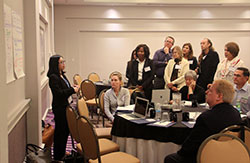After attending the Diversity Program Consortium (DPC) annual meeting in mid-October and learning about the progress the consortium has made and its future plans, we’re feeling energized as we begin the third year of this grant. The DPC, supported by the NIH Common Fund and managed by NIGMS, is a cooperative agreement focused on finding the best ways to improve research training and mentoring in the biomedical sciences and on engaging a more diverse field of individuals in biomedical research careers. The consortium includes three interconnected programs: Building Infrastructure Leading to Diversity (BUILD), the National Research Mentoring Network (NRMN) and the Coordination and Evaluation Center (CEC).
The annual meeting brought together over 100 representatives from NIH and each grantee site to discuss DPC achievements, challenges and opportunities. The agenda, organized by the CEC, included two full days of presentations and breakout sessions.
During one breakout session, attendees from the 10 BUILD sites and NRMN shared what they perceive as their most important outcomes from the past two years. This self-reflection activity helped attendees use data to examine what’s working well programmatically. In small groups, the attendees discussed their progress, examined the sites’ measurable outcomes and identified commonalities. These discussions fostered potential collaborations and emphasized the importance of each site’s ongoing data collection to achieving one of the consortium’s goals: analyzing program and student outcomes to more effectively address the needs of diverse populations in biomedical research.

Attendees also shared some of the new programs they have designed to better prepare students for graduate school and research careers. So far, over 500 students have been supported by BUILD programs. Many institutions have used BUILD funding to improve research capacity through renovating labs, creating active-learning classrooms and providing faculty members with pilot project grants for wide-ranging projects, from curriculum redesign to biomedical research.
Another meeting highlight was the CEC’s detailed presentation on the ways information from the sites will be consolidated and the types of reports the CEC will generate on interventions at the student, faculty and institutional levels. As you might expect, collecting data from such a large-scale enterprise is time consuming, and it was refreshing to hear the CEC’s new ideas to simplify this process for institutions and students. These include developing a mobile application that will keep track of participation at BUILD events and a data tracker to help the sites collect and organize data.
We’re looking forward to seeing the innovations and programs that the sites develop over the next years of the grant.
To stay up to date with the consortium sites and their news, “like” our NIH Diversity Program Consortium Facebook page and follow us @NIHdpc on Twitter.

